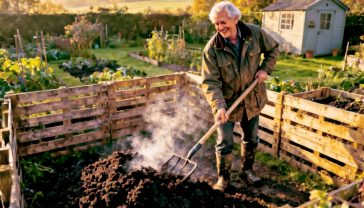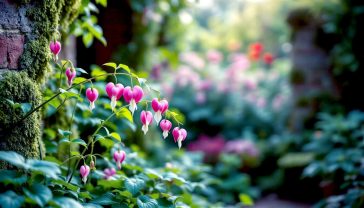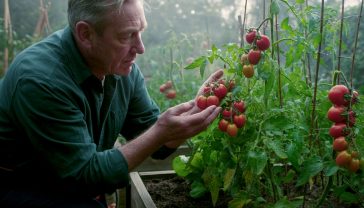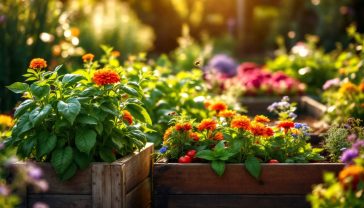The Great British Compost Showdown: Heap vs. Bin – Which Is Best?
The guide to choosing between a traditional compost heap and a modern compost bin. We break down the pros, cons, and secrets to making perfect compost.
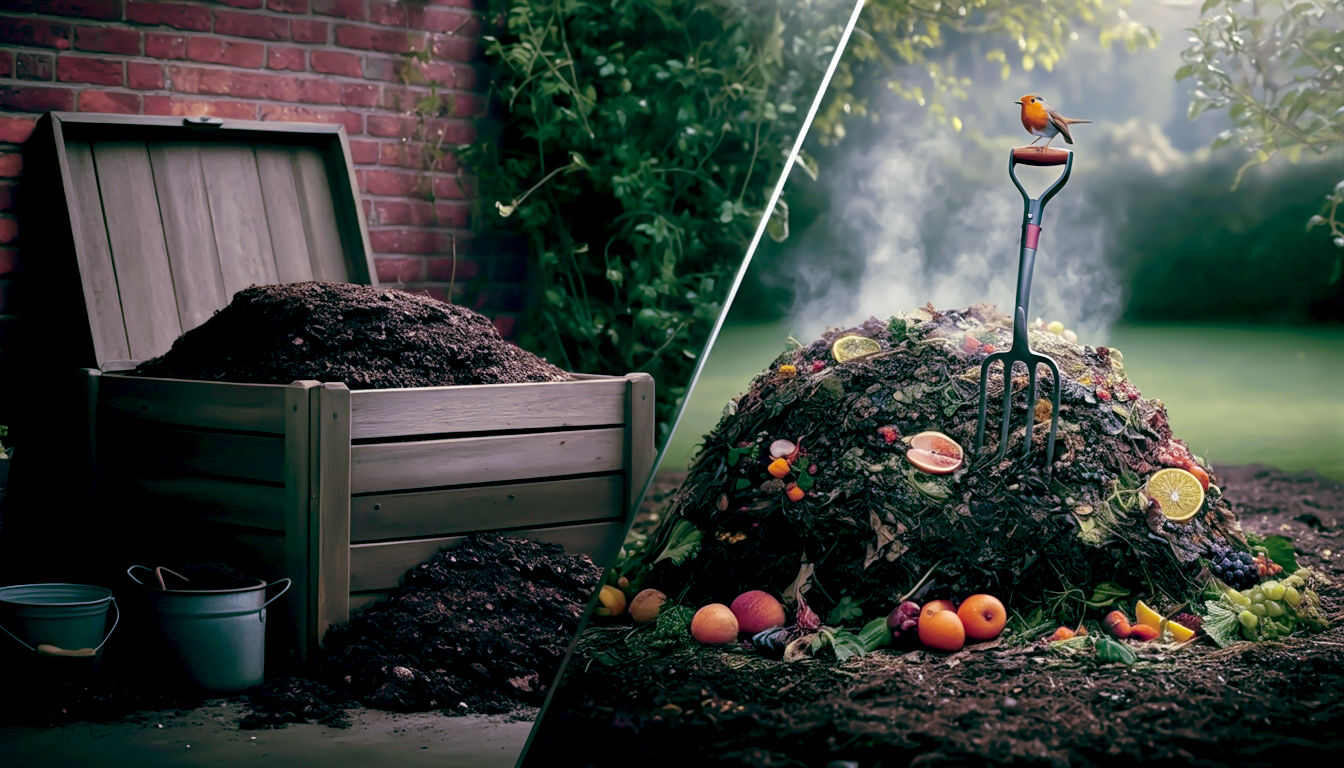
This post may contain affiliate links. If you make a purchase through these links, we may earn a commission at no additional cost to you.
Right then, let’s talk about rot. Not the bad kind, like when your favourite shed finally gives up the ghost. We’re talking about the magical, beautiful, life-giving rot that happens in a quiet corner of the garden. We’re talking about composting.
For gardeners up and down the country, from sprawling allotments in the Midlands to tiny patios in London, creating compost is a rite of passage. It’s the ultimate act of recycling – turning potato peelings, grass clippings, and that mountain of cardboard from online shopping into ‘black gold’. This dark, crumbly, sweet-smelling stuff is the secret to healthier plants, bigger veg, and a garden that truly thrives.
But a question has long divided the nation’s gardeners, sparking quiet debates over garden fences and in muddy allotment sheds. It’s a fundamental choice that defines your composting journey: do you go for a traditional, no-nonsense compost heap, or a neat, contained compost bin?
It’s not just a simple choice. It’s a decision about space, effort, aesthetics, and even your relationship with the local wildlife (we’re looking at you, Mr. Rat). Fear not. In this guide, we’ll dig deep into the world of heaps and bins, unearthing the pros and cons of each. We’ll break down the science in a way that makes sense, tackle the problems you might face, and help you decide, once and for all, which method is the perfect match for you and your British garden.
So, grab your gardening gloves and a cup of tea. It’s time to get stuck in.
First Things First: What on Earth is Composting?
Before we pit heap against bin, let’s get the basics sorted. In the simplest terms, composting is nature’s way of recycling. It’s the process of letting organic stuff – like garden waste and kitchen scraps – decompose and break down into a rich, soil-like material.
Think of a forest floor. Leaves, twigs, and fallen trees don’t just sit there forever. They’re slowly broken down by an army of tiny workers. This army includes:
- Bacteria: The microscopic powerhouses doing most of the heavy lifting.
- Fungi: The web-like threads that break down the tougher, woody materials.
- Insects and Worms: The bigger critters that chew, shred, and mix everything up.
When you create a compost pile, you’re essentially building a five-star hotel for this clean-up crew. You give them the right ingredients – food, water, and air – and they get to work, turning your rubbish into a gardener’s treasure. This final product is packed with nutrients that feed your plants and improve your soil’s structure, helping it hold water in the summer and drain well in our notoriously wet winters.
Meet the Contenders: A Tale of Two Composting Styles
Now, let’s meet the two main players in our showdown. They both achieve the same goal, but they go about it in very different ways.
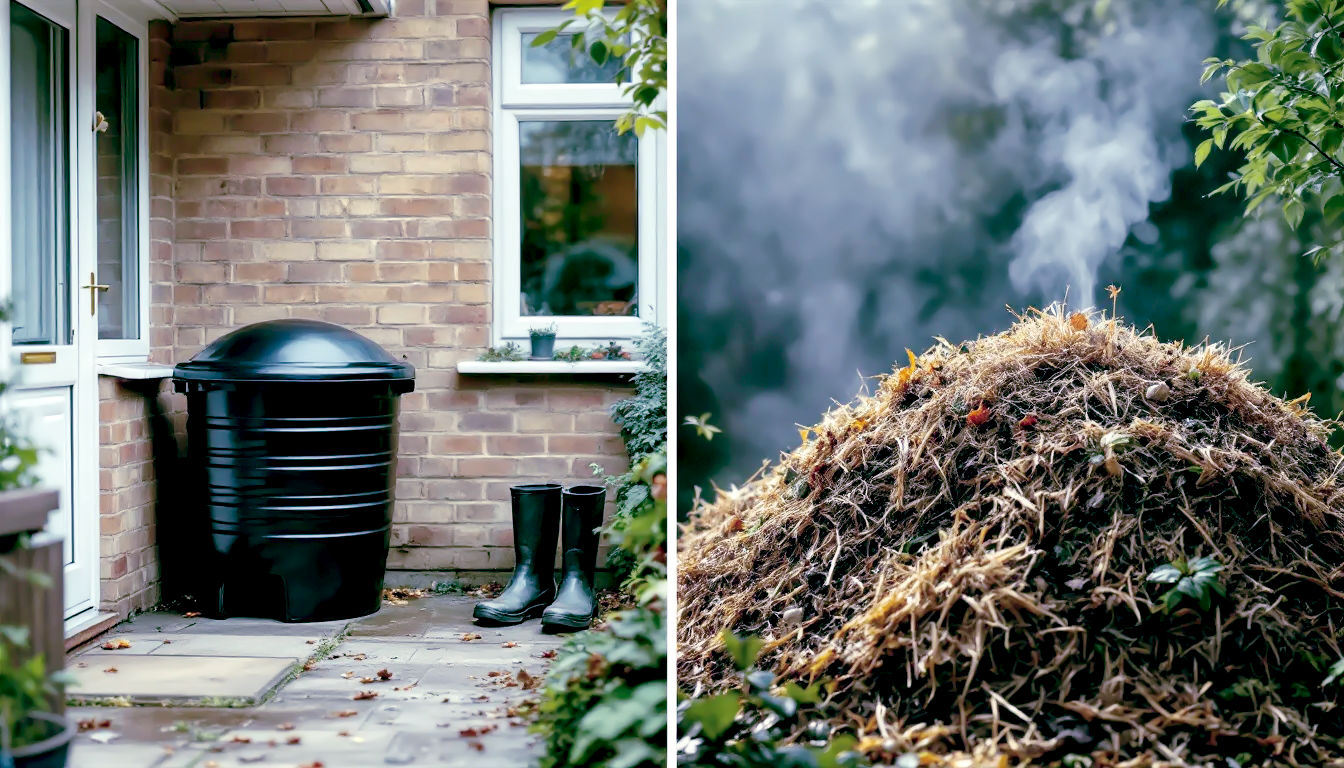
The Traditional Compost Heap: Wild, Free, and Uncontained
The compost heap is the old-school original. It’s exactly what it sounds like: a pile of organic waste, left in a corner of the garden to do its thing. This is the method of our grandparents, the backbone of allotments, and the choice for those with plenty of space and a more relaxed approach to gardening.
You don’t need any special equipment to start a heap. Just choose a spot and start piling up your waste. It’s the composting equivalent of a country ramble – a bit wild, wonderfully simple, and completely free.
Why You Might Love a Heap: The Pros
Why You Might Fall Out with a Heap: The Cons
The verdict on the heap: It’s perfect for gardeners with large spaces, a lot of waste, and a laid-back attitude. If you’re not worried about looks or the occasional furry visitor, the simplicity and scalability of a heap are hard to beat.
The Contained Compost Bin: Tidy, Tamed, and Terrifically Efficient
The compost bin is the modern solution to home composting. It’s a container, usually made of plastic or wood, designed to keep your composting efforts neat, tidy, and under control. They are the go-to choice for urban and suburban gardens where space is tight and tidiness is a priority.
Bins come in all shapes and sizes, from the familiar council-subsidised ‘Dalek’ to stylish wooden boxes and clever rotating tumblers.
Why You Might Love a Bin: The Pros
Why You Might Fall Out with a Bin: The Cons
The verdict on the bin: It’s the ideal choice for most small to medium-sized gardens. If you value tidiness, want to avoid pests, and are keen to get your hands on finished compost relatively quickly, a bin is your best bet.
The Science Bit: A Simple Recipe for Rotted Success
Whether you choose a heap or a bin, the science behind what makes it work is exactly the same. Getting it right is a bit like baking a cake – you need the right ingredients in the right proportions.
Your composting army needs four key things to thrive:
- Greens (Nitrogen): Think of these as the high-energy fuel. They are soft, moist materials that rot down quickly.
- Browns (Carbon): These are the slow-burn energy source. They are drier, woodier materials that provide structure and allow air to circulate.
- Air (Oxygen): Your microbes need to breathe. Without air, a different, smellier type of bacteria takes over.
- Water (Moisture): The pile should be as damp as a wrung-out sponge. Not soggy, not bone-dry.
Getting the Balance Right: The Secret C:N Ratio
The key to great compost is the ratio of ‘Browns’ (Carbon) to ‘Greens’ (Nitrogen). Don’t worry, you don’t need a degree in chemistry. A good rule of thumb is to aim for roughly one part Greens to two parts Browns by volume.
Here’s a quick guide to what’s what:
| Greens (Rich in Nitrogen) | Browns (Rich in Carbon) |
|---|---|
| Grass Clippings | Cardboard & Paper (torn up) |
| Vegetable & Fruit Peelings | Egg Boxes & Toilet Roll Tubes |
| Tea Bags & Coffee Grounds | Twigs, Prunings & Wood Chips |
| Young Weeds (before they set seed) | Straw & Hay |
| Nettle & Comfrey Leaves | Dead Leaves |
| Chicken Manure | Sawdust & Wood Shavings |
Getting this mix right prevents most common composting problems.
- Too many Greens? You’ll end up with a wet, smelly, slimy sludge.
- Too many Browns? Your pile will be too dry and will take an eternity to break down.
What Should Never Go in Your Compost?
Just as important is knowing what to leave out. Avoid these at all costs, as they can attract pests and introduce nasty diseases:
- Meat, Fish, and Bones: A huge magnet for rats.
- Dairy Products (Cheese, Milk, Yoghurt): Ditto.
- Cooked Food, Bread, and Pasta: Attracts vermin and can turn your compost into a slimy mess.
- Diseased Plants: You don’t want to spread diseases back into your garden.
- Pernicious Weeds: Things like bindweed or couch grass can survive the composting process and pop up everywhere.
- Cat or Dog Poo: Can contain harmful pathogens.
- Coal Ash or Glossy Magazines: Contain chemicals you don’t want in your soil.
Head-to-Head: The Definitive Compost Comparison
So, you understand the contenders and the science. Let’s put them side-by-side to help you make your final decision.
| Feature | Compost Heap | Compost Bin | The Bottom Line |
|---|---|---|---|
| Cost | Free! | £20 – £200+ | Heap wins if you’re on a tight budget. |
| Space | Needs a large area (at least 1m x 1m). | Compact footprint, ideal for small gardens. | Bin is the only real option for smaller spaces. |
| Speed | Slower (Cold Composting). 1-2 years. | Faster (Hot Composting). 3-12 months. | Bin wins for gardeners who want compost quickly. |
| Effort | Easy to add to, but needs turning to work well. | Can be harder to mix/turn. Requires some management. | It’s a tie. Both require some effort for the best results. |
| Aesthetics | Can look messy and untidy. | Neat, contained, and discreet. | Bin wins for anyone who likes a tidy garden. |
| Pest Control | Poor. Open invitation to rats and foxes. | Excellent. A good lid keeps pests out. | Bin is the clear winner for peace of mind. |
| Climate Control | Loses heat and moisture easily. | Retains heat and moisture, working better in winter. | Bin performs more consistently in the British climate. |
| Nutrient Quality | Good, but nutrients can be leached by rain. | Excellent, as nutrients are contained. | Bin generally produces a slightly richer end product. |
| Best For… | Large gardens, allotments, high volumes of waste, budget-conscious gardeners. | Small-to-medium gardens, urban areas, tidy gardeners, pest-conscious households. | It’s all about matching the method to your circumstances. |
A Practical Guide for the British Gardener
Theory is great, but let’s get our hands dirty. Here’s how to get started, whether you’ve chosen a heap or a bin.
How to Build the Perfect Compost Heap
- Choose Your Spot: Find a level, well-drained patch of bare earth. A bit of shade is ideal to stop it from drying out too fast in summer. Don’t put it on concrete or paving, as you want worms and other critters from the soil to be able to get in and help.
- Lay the Foundations: Start with a 6-inch layer of twiggy material at the bottom. This helps with drainage and aeration.
- Start Layering: Now, build up your heap like a lasagne. Add a layer of Greens, then a thicker layer of Browns. Repeat. Water each layer lightly if the material is dry.
- Give it a Kick-Start: You can add a “compost activator” to speed things up. Good activators include a shovelful of existing compost, some rich garden soil, or even a handful of chicken manure pellets.
- Keep it Covered: To retain moisture and heat, cover the top of your heap with a piece of old carpet, a tarpaulin, or a layer of cardboard.
- Turn It: For the best results, use a garden fork to turn the heap every month or so. This mixes everything together and gets oxygen in, which speeds up the whole process.
How to Master Your Compost Bin
- Location, Location, Location: As with a heap, place your bin on bare earth to let the worms in. A sunny spot can help it heat up faster, but a partially shaded spot is fine too. Make sure you have space to get a wheelbarrow to it.
- The First Layers: Just like a heap, start with a base of twiggy material or scrunched-up cardboard to ensure good airflow at the bottom.
- Fill it Up: Add your Greens and Browns in alternating layers. It’s a good idea to keep a bag of ‘Browns’ (like shredded paper or dead leaves) next to your bin, so you can add a layer every time you empty your kitchen caddy.
- Keep it Moist: Check the moisture levels now and then. If it looks dry, add a watering can of water. If it’s too wet, add more dry ‘Browns’ to soak up the excess.
- Mix It Up: Turning the contents of a bin is harder, but still important. Every few weeks, use a garden fork or a special compost aerator tool to mix things around as best you can.
- Harvesting the Goods: Your finished compost will be at the bottom. Most bins have a hatch that lets you shovel out the dark, crumbly gold from below while newer material continues to rot down from the top.
Troubleshooting: Solving Common Compost Calamities
Even the best-laid plans can go awry. Here’s how to solve the most common composting problems.
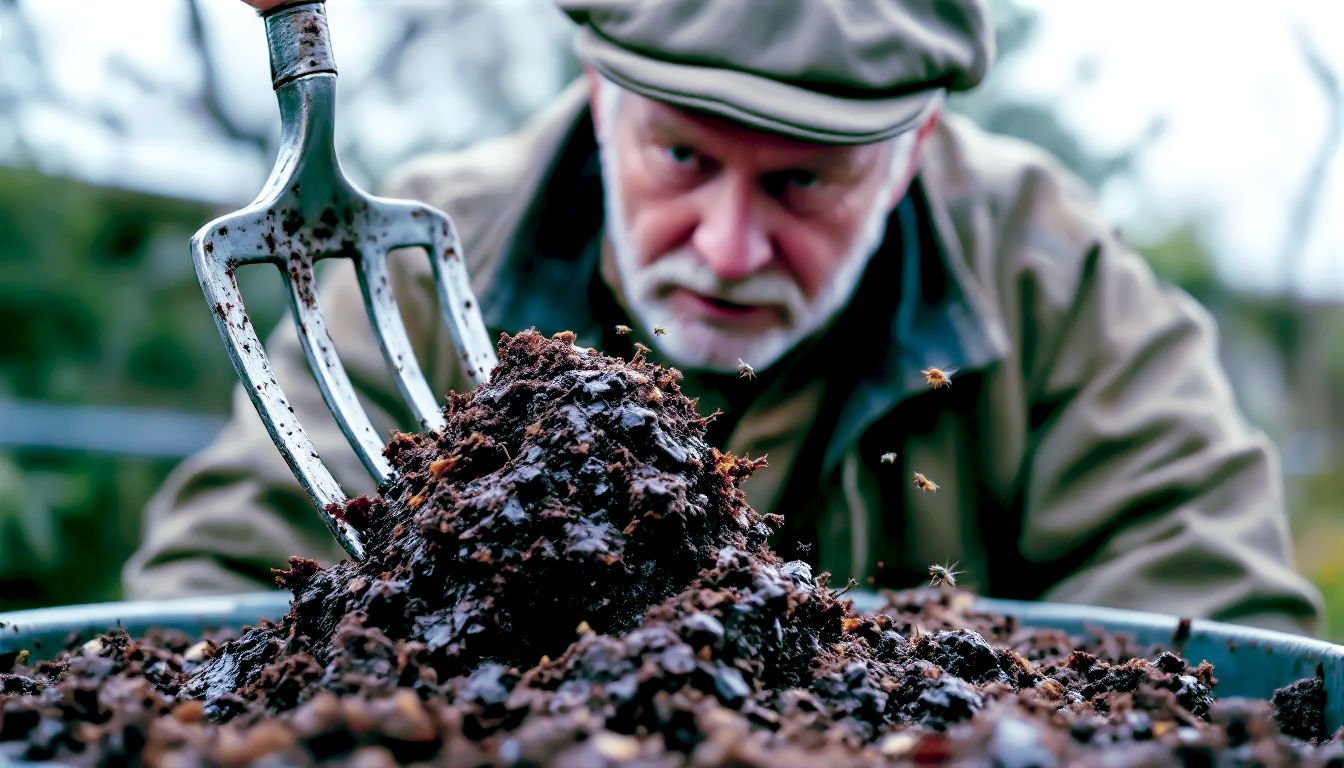
- Problem: “My compost is a smelly, slimy mess!”
- Cause: It’s too wet and doesn’t have enough air. You’ve likely added too many Greens (like grass clippings).
- Solution: Add lots of dry ‘Browns’ – shredded cardboard, screwed-up newspaper, or dry leaves are perfect. Get in there with a fork and mix it all up thoroughly to introduce air. Leave the lid off your bin for a day or two if it’s not raining.
- Problem: “Nothing is happening. It’s just a dry pile of rubbish.”
- Cause: It’s too dry, has too many ‘Browns’, or both. The microbes have gone on strike.
- Solution: Add some water with a watering can to get it to that ‘damp sponge’ consistency. Then, mix in a good load of ‘Greens’ like vegetable scraps or fresh grass clippings to give it a nitrogen boost and kick-start the process.
- Problem: “Help, I’ve got rats!”
- Cause: Most likely in a heap. Rats are attracted by warmth and, more importantly, a food source. You’ve probably added cooked food, meat, or bread.
- Solution: Immediately stop adding any forbidden items. Turn the heap thoroughly with a fork every few days to disturb any nests. If the problem persists, your best bet is to dismantle the heap and start again inside a secure, pest-proof compost bin.
- Problem: “It’s swarming with fruit flies!”
- Cause: You’re leaving kitchen scraps exposed on the surface.
- Solution: This is an easy fix. Every time you add kitchen waste, make sure to cover it with a layer of ‘Browns’ or some grass clippings. Burying it in the centre of the pile works a treat.
The Verdict: So, Which is Best for You?
After all that, we come back to our original question: heap or bin? The truth is, there’s no single ‘best’ answer. The best composting system is the one that you will actually use, and that fits your garden, your budget, and your lifestyle.
- Choose a HEAP if: You have a large garden or allotment, produce huge amounts of garden waste, aren’t concerned about a perfectly tidy appearance, and are happy to wait a bit longer for your finished compost.
- Choose a BIN if: You have a small or medium-sized garden, value neatness, live in an urban area where pests are a concern, and want a faster, more efficient process.
For the vast majority of British gardeners, a compost bin is the most practical and effective choice. It neatly solves the biggest drawbacks of the open heap – aesthetics and pests – while creating fantastic compost in a shorter amount of time.
But whichever you choose, the most important thing is simply to start. Composting is one of the easiest and most rewarding things you can do for your garden and for the planet. You reduce your waste, cut your carbon footprint, and in return, you get a constant supply of the best soil improver money can’t buy.
So, pick your corner, choose your contender, and start turning today’s rubbish into tomorrow’s roses. Your garden will thank you for it.
Further Reading
To continue your composting journey, here are some of the most respected resources in the UK:
- The Royal Horticultural Society (RHS): Composting Advice
- Garden Organic: Composting for Beginners
- Gardeners’ World Magazine: How to Make Compost

